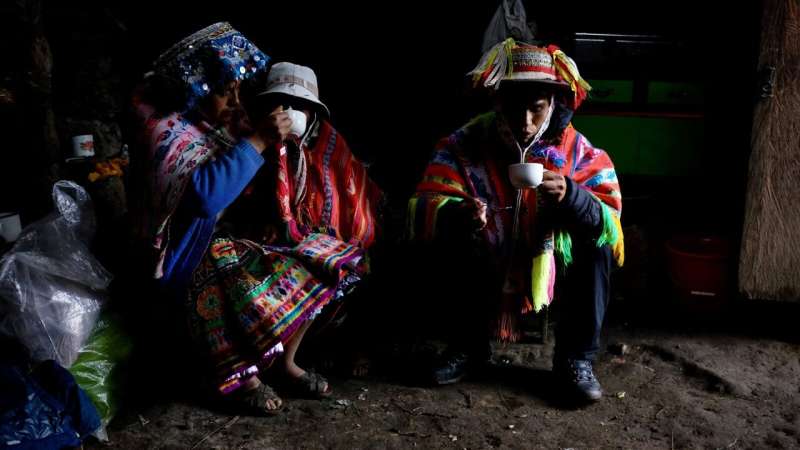This article has been reviewed according to Science X's editorial process and policies. Editors have highlighted the following attributes while ensuring the content's credibility:
fact-checked
peer-reviewed publication
trusted source
proofread
Harnessing human evolution to advance precision medicine

Humans are still evolving, and Tatum Simonson, Ph.D., founder and co-director of the Center for Physiological Genomics of Low Oxygen at University of California School of Medicine, plans to use evolution to improve health care for all.
Her latest research, which was published February 9, 2024 in Science Advances, reveals that a gene variant in some Andean people is associated with reduced red blood cell count at high altitudes, enabling them to safely live high in the mountains in low-oxygen conditions. Simonson's UC San Diego lab is applying those findings toward understanding whether there may be a genetic component to why some people with sleep apnea or pulmonary diseases such as chronic obstructive pulmonary disease (COPD) fare better than others.
Explained Simonson, "There are people with COPD who breathe a lot and maintain a higher oxygen saturation. Others with the same disease don't breathe as much, and their oxygen saturation is low. Researchers suspect there may be genetic differences underlying this variation, similar to the variation we find in pathways important for oxygen sensing and responses underlying natural selection at high altitude."
Our cells need oxygen to survive. When there isn't enough in the environment, our bodies produce extra red blood cells, which transport oxygen throughout the body. Too many red blood cells, however, create a dangerous condition called excessive erythrocytosis (EE), which makes the blood viscous, which could lead to stroke or heart failure.
Her previous research showed that many mountain-dwelling Tibetans exposed to low-oxygen situations are born with innate mechanisms that protect them from poor outcomes at high altitude, including the overproduction of red blood cells. Part of this is due to changes in the regulation of the EPAS1 gene, which lowers hemoglobin concentrations by regulating the pathway that responds to changing oxygen levels. Advances in genetics have shown that modern Tibetans received this genetic advantage from their ancestors who mixed with archaic humans living in Asia tens of thousands of years ago—a unique evolutionary history confined to this population.
For her latest research, Dr. Simonson, who is also the John B. West Endowed Chair in Respiratory Physiology and associate professor in the Division of Pulmonary, Critical Care, Sleep Medicine & Physiology at UC San Diego School of Medicine, zoomed in on the EPAS1 region of the genome. She and her team focused on a mutation in the gene that is present in some people living in the Andes but is absent in all other human populations. When they scanned whole Andean genomes, they found a pattern surrounding this variant suggesting that the genetic change, which alters only a single amino acid in the protein product, happened by chance, relatively recently (from 9,000 to 13,000 years ago), and spread very quickly through hundreds of generations within the Andean population.
Similar to Tibetans, the EPAS1 gene is associated with lower red blood cell count in Andeans who possess it. However, the researchers were surprised to find that the variant works in a completely different way from the Tibetan version of the gene; rather than regulating its levels, the Andean variant changes the genetic makeup of the protein, altering the DNA in every single cell.

"Tibetans have, in general, an average lower hemoglobin concentration, and their physiology deals with low oxygen in a way that doesn't increase their red blood cells to excessively high levels. Now we have the first signs of evidence that Andeans are also going down that path, involving the same gene, but with a protein-coding change. Evolution has worked in these two populations, on the same gene, but in different ways," said Simonson.
This study exemplifies a current approach in research that connects genetic targets of natural selection with complex disease genes—understanding, for example, how natural genetic variation contributes to adaptive and maladaptive responses to low oxygen, as this study reveals.
In Simonson's lab, that means figuring out what downstream target genes are being turned on in response to low oxygen, among other things. Said Simonson, "This paper shows one gene associated with one particular phenotype, but we think there are many different genes and components of oxygen transport involved. It's just one piece of that puzzle, and could provide researchers with information relevant to other populations."
Simonson and her team are working with Latino populations in San Diego and El Centro, California, as well as Tijuana and Ensenada, Mexico, taking them to high altitudes and recording their breathing while awake and asleep. They're cross-referencing their findings with publicly available databases to determine whether the findings they've made in Andeans are also found in local Latinos who may share some genetic variants with the Andeans.
"In precision medicine, it's important to recognize variation in genetic backgrounds, specifically in historically understudied populations," Simonson said. "If we can find some shared genetic factors in populations in an extreme environment, that may help us understand aspects of health and disease in that group and groups more locally. In that way, this study aims to push research forward, and towards comprehensive personalized medicine approaches in clinics here in San Diego."
More information: Elijah S. Lawrence et al, Functional EPAS1 / HIF2A missense variant is associated with hematocrit in Andean highlanders, Science Advances (2024). DOI: 10.1126/sciadv.adj5661

















